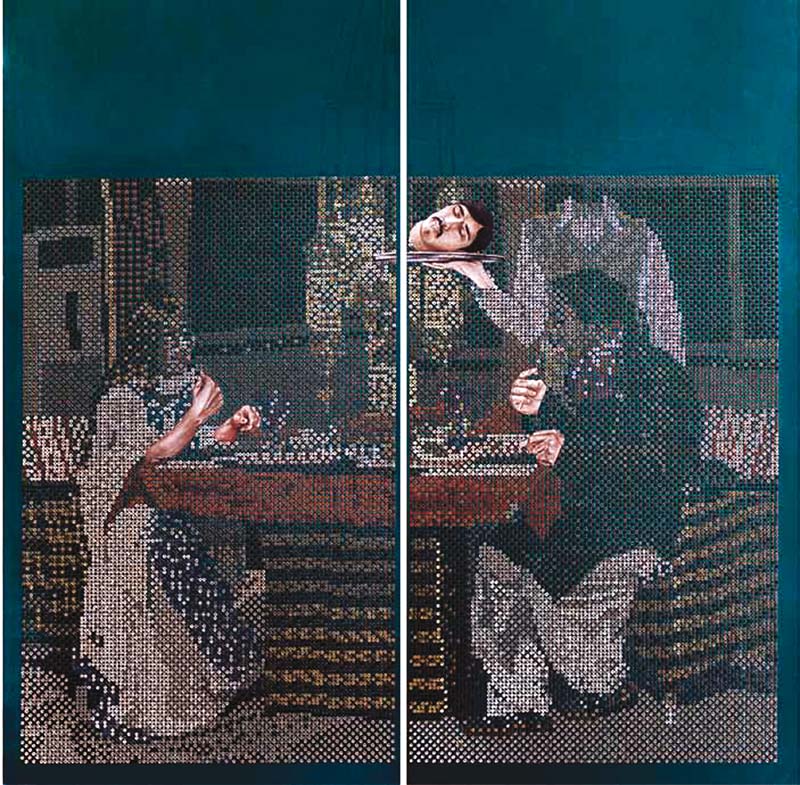
Dua Abbas’s charcoal and pastel piece Long Distance is hauntingly beautiful. With a conch shell and telephone receiver superimposed on an idyllic endless sea, it evokes childhood memories where waves are believed to communicate through shells. The piece also explores memory and the passage of time, as well as a false sense of hope, where one enters a make-believe relationship that does not necessarily exist.

Saba Khan’s Eating Fries, beads and acrylic on Hahnemuhle paper. PHOTO COURTESY: SANAT GALLERY
Abid Aslam’s artistic practice is unique because it involves the use of plastic grommets or eyelets punched into wasli (handmade paper). Depicting a vexing scene with a waiter serving a human head to a fine-dining couple, his diptych Lovers’ Dinner, according to art critic Nafisa Rizvi, reminds one of the “biblical account of the Last Supper in which food and drink were associated with physical human attributes….” The hands and human head are painted in detailed miniature technique and the piece evokes ideas of the marginalisation of certain groups of society.
Irfan Gul Dahiri’s Still Untitled, acrylics on wasli, is an enigmatic, dark and foreboding piece. What dominates the composition is a large, yellow form, depicting a cross between a flower and a bunch of bananas, strung together by what looks like an emblazoned helmet. To its left is a much smaller, beautifully painted, wilted flower, and the dark background reveals abstract human forms, perhaps mutilated.

Dua Abbas’s Long Distance, charcoal and pastel. PHOTO COURTESY: SANAT GALLERY
Irfan Hasan displays skill and dexterity with Self Portrait as David with the Head of Goliath, After Johann Zoffany. Stemming from his ‘After’ series that pays homage to Renaissance masters, the piece involves the Mughal miniature medium of opaque watercolour on paper. The phrase ‘David and Goliath’ here is used to denote a situation where a weaker opponent faces a stronger adversary, perhaps reflecting Hasan’s struggle to emulate Renaissance masters.
Donia Kaiser’s Sleep Walking is bold and dramatic, depicting a recently occupied, unmade bed in the spotlight. Emerging from the bedside table is a haunting, blue, bare tree and a red moon, reminding one of dark forests and nightmares.
Ali Kazim’s Untitled I and II (The Storm Series), at first, seem to depict calm clouds in unidentifiable locations that either hover above or seem to rest on a surface. However, a closer look reveals the opposite; these are desert storms rushing towards or away from the viewer, destroying everything in their wake.
Saba Khan’s Eating Fries stands out from the rest. In mixed media, a blonde woman is depicted (literally) eating fries. The work speaks of rampant consumerism, globalisation of tastes and foreign influence into Pakistani culture.

Irfan Gul Dahri’s Still Untitled, acrylic on wasli. PHOTO COURTESY: SANAT GALLERY
Eminent artist and art-educator RM Naeem’s acrylic on canvas Still+Life wows with his skill, displaying a man and woman separated on either end of a table by cubistic, pyramidal and spherical shapes. He, perhaps, questions (and balances) the praxis of spirituality versus religion, male versus female, as well as the genre of still life versus real life.
Naveed Sadiq’s Untitled depicts, in colour pencil, an incredibly realistic looking pair of feet as seen from a voyeuristic, introspective point of view. Across them, one can faintly make out an assemblage of thorns. The message it gives is that it is our feet that allow us to travel; yet, these very feet can be shackled and bound.
Other artists exhibiting soulful pieces in Silsila 2015 include Sadaf Naeem, Sana Arjumand, Mudassar Manzoor, Faisal Asghar, Nazia Gull, Kiran Saleem, Irfan Gul Dahiri, Mizna Baluch, Akif Suri, Adeel uz Zafar, Muhammad Zeeshan and Amra Khan. It is left to the viewer to decide whether the artists’ pieces successfully fall under the classifications they claim to be under, or is art today too integrated to fall under a single category.
Shanzay Subzwari is an artist and art writer based in Karachi. She tweets @ShanzaySubzwari
Published in The Express Tribune, Sunday Magazine, May 24th, 2015.

































1714024018-0/ModiLara-(1)1714024018-0-270x192.webp)









COMMENTS
Comments are moderated and generally will be posted if they are on-topic and not abusive.
For more information, please see our Comments FAQ